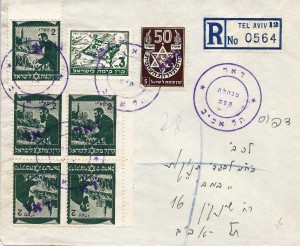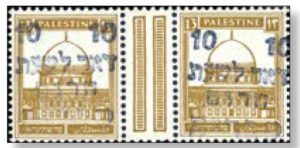*The Interim Period II has two time frames:
♦ the “Philatelic” Time Frame.
♦ the “Official” Time Frame.
“Philatelic” Time Frame
-
-
- On March 15, 1948 the British notified secondary and outlying post offices that their functions were terminated. The Nahariya to Haifa Emergency Boat Mail service began on March 22, 1948.
- For Jerusalem, as late as August 8, 1948 there was a use of a provisional stamp prepaying a letter.
-
“Official” Time Frame
-
-
- The REMAINING last day of British Postal service was May 5, 1948.
- On May 16, 1948, the first stamps of Israel became available, and this was the start of the official Israel postal service.
-
NOTE: See “HISTORICAL AND PHILATELIC BACKGROUND” below for more details.
NOTE: “These stamps must be considered as provisional or local issues as they were not recognized by the Universal Postal Union for the prepayment of international mail.
However, they were used for domestic mail and were valid within the areas of Palestine under Jewish control.”
(Forsher, p. Preface)
HISTORICAL AND PHILATELIC BACKGROUND
ABBRIVIATED HISTORICAL BACKGROUND.
“In order to understand the reasons leading to the releases of all the various Interim Period issues, knowledge about conditions which existed in Palestine shortly before the proclamation of the State of Israel and what happened shortly after this event appear to be essential. This chapter will only provide the reader with a brief summary of this period as the entire history of the War of Independence is beyond the scope of this handbook. Additional reading is therefore recommended. Other references listed in the section of Bibliography will provide additional philatelic background and information which will prove to be both interesting and informative.” (Forsher, p.2)
“During this period, the British Mandate government appeared to be completely unconcerned with what was occurring in Palestine and only concerned with their preparation to leave. They were totally uninterested in turning over to the Jews any governmental function. They were only concerned with the liquidation of their own services. Troops started to embark for England as early as February 1948. By May 10, 1948, only a token force remained in Jerusalem, while heavy fighting between Arabs and Jews broke out, offering protection to the British High Commissioner only. When he left on May 14, 1948, British rule in Palestine ended. The same day, in the afternoon of May 14th, the State of lsrael was proclaimed.” (Forsher, p. 3)
The heaviest fighting occurred between the early part of May and June 10, 1948. During this period, the regular armies of Syria, Jordan and Egypt, reinforced by detachments from Iraq and from the Arab Legion, a British mercenary outfit, attempted to invade Palestine.
Meanwhile, the United Nations attempted to stop the open warfare and it eventually managed to establish a first truce which became effective on June 10th, 1948. . . . The first truce expired on July 9, and fighting was resumed on all fronts. (Forsher, p. 4)
Practically beaten in a military sense the Arabs agreed now to a third truce and to negotiate an armistice agreement. These agreements were negotiated separately with each of the aggressors on the Isle of Rhodes between February and July, 1949.
The negotiation and the signing of a peace treaty has yet to materialize. (Forsher, p.5)
ABBRIVIATED PHILATELIC BACKGROUND.
After the adoption of the United Nations resolution of November 29, 1947 it appeared for a short time that a United Nations Commission would be established to assume the functions of the outgoing British Mandate Government such as, for instance, the postal services. Therefore, the design of a trilingual stamp (U.N. Commission for Palestine) was commenced. However, the British Mandate Government indicated from the outset their total lack of interest to cooperate with the United Nations and they refused the U.N. Commission even a permit to visit Palestine prior to the British departure. Hence, these stamps never progressed past a preliminary design stage.
When this attitude became apparent, it was expected by the Jewish leaders that the British officials would tum over to them the vital government functions such as the operation of the post offices, piecemeal or wholesale. However, this too failed to materialize. The British Mandate officials were planning only the liquidation and not any continuation of such services. In the case of the postal services, this came about in three phases.
On March 15, 1948, secondary and outlying post offices were informed by telephone that their functions had been terminated. The first announcement came as a complete surprise to the Jewish leaders and it completely stunned the effected Jewish settlements. On April 15, 1948, a majority of the remaining offices were closed in a similar manner, leaving only the main offices in the major cities operating under the British postal rules, and they were closed (nominally) on May 5, 1948. (Forsher, p. 6)
REFERENCES
- THE INTERIM PERIOD POSTAGE STAMPS OF ISRAEL, MARCH TO JULY 1948. Second Printing, September 2014. Bruno J. Forsher Photography by L. I. Edos. A HANDBOOK OF THE SOCIETY OF ISRAEL PHILATELISTS. Published by the Educational Fund of the Society of Israel Philatelists. (NOTE: this publication has a Bibliography of “66”entries.)
- AN INTRODUCTION TO THE INTERIM PERIOD OF 1948. The Israel Philatelist, Volume 39, No. 11-12. Suse Judith. pp 5555 – 5559.
- A Brief Overview Of Holy Land Philately. The Israel Philatelist. Spring, 2017. Sid Morginstin. pp. 52 -53.
- BALE Catalogues. Israel Postage Stamps. Specialized catalogue 1948 – 2016. 24th Edition. Compiled and Edited by Joseph D. Stier. 2016,
Tel Aviv.



